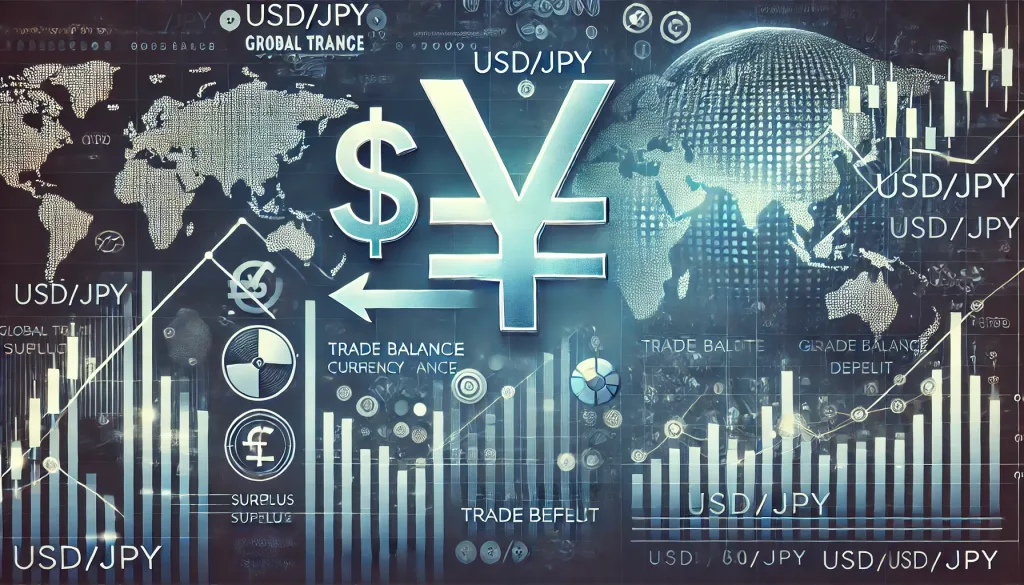USD/JPY and Trade Balance: The Hidden Formula for Forex Success

USD/JPY + Trade Balance: Unearthing Forex Market Secrets for Savvy Traders
The USD/JPY Trade Balance Connection: More Than Just Numbers
Think of the USD/JPY pair as a high-stakes tug-of-war between two economic giants. On one side, you’ve got the U.S., a voracious importer, and on the other, Japan, a manufacturing powerhouse. At the heart of their tussle? Trade balance.
In Forex trading, understanding the trade balance—the difference between a nation’s exports and imports—is like knowing the secret ingredient in grandma’s pie recipe. It’s not flashy, but it’s essential to predicting currency movements. When Japan’s exports soar, demand for the yen increases, often pushing USD/JPY down. Conversely, a trade deficit can send the yen sliding, giving the dollar an edge.
Here’s the kicker: it’s not just about the numbers. It’s about context. What’s driving the trade surplus or deficit? How are global trends—like supply chain disruptions or energy prices—impacting these dynamics? Let’s dig deeper.
The Trade Balance Sweet Spot: Spotting Market Opportunities
1. Timing Is Everything
Trade balance data is released monthly, and savvy traders know to mark their calendars. It’s like anticipating a plot twist in your favorite TV show—the buildup is everything. The Bank of Japan’s trade data often creates volatility in USD/JPY, presenting short-term trading opportunities.
Pro Tip: Watch for deviations from forecasts. For example, if analysts expect a $2 billion surplus and the actual figure comes in at $4 billion, expect the yen to strengthen against the dollar.
2. Correlating Trade Balance with Export-Heavy Sectors
Japan’s trade balance is heavily influenced by exports in tech, automobiles, and machinery. Keeping tabs on earnings reports from giants like Toyota or Sony can give you an early edge. Strong corporate earnings can signal a higher trade surplus, strengthening the yen.
3. The Energy Angle
Japan imports most of its energy, making the yen sensitive to oil price fluctuations. If crude oil prices spike, expect a dent in Japan’s trade balance and potential weakness in the yen. Combine this with the USD/JPY pair for high-probability trades during energy market upheavals.
Advanced Strategies for USD/JPY Based on Trade Balance
The Divergence Play
Sometimes, the USD/JPY chart tells a story that doesn’t align with trade balance data. This is where divergence trading comes in. For example:
- Scenario: Japan posts a trade surplus, but USD/JPY rises due to external factors (e.g., U.S. rate hikes).
- Tactic: Use technical analysis to confirm overbought conditions on USD/JPY and prepare for a correction.
Hedging Against Uncertainty
Trade balance data is notoriously unpredictable. Hedge your positions by:
- Diversifying across correlated pairs like EUR/JPY or AUD/JPY.
- Using options to cap downside risk while keeping upside potential.
Scalping the News
For adrenaline junkies, trade balance announcements offer prime scalping opportunities. Set tight stop losses and leverage liquidity spikes immediately after data releases. Tools like economic calendars can help you stay ahead.
Common Pitfalls (and How to Dodge Them)
Ignoring the Bigger Picture
Trade balance is a piece of the puzzle, not the whole picture. Always consider other macroeconomic factors like interest rates, inflation, and geopolitical tensions.
Overreacting to One Report
Markets love drama, but as a trader, you should focus on trends rather than single data points. If Japan posts a trade deficit for one month, it doesn’t mean USD/JPY is set for a long-term rally.
Insider Tips for Mastering USD/JPY and Trade Balance
- Use Trade Balance as Confirmation: Combine trade balance analysis with technical setups for stronger conviction.
- Leverage Economic Calendars: Platforms like StarseedFX’s Forex News can keep you informed of key data releases.
- Join a Trading Community: Get daily alerts and insights from experts at StarseedFX Community.
Quick Wins: Elite Tactics in Bullet Points
- Monitor Japan’s export-heavy sectors for trade balance clues.
- Watch crude oil prices to gauge yen sensitivity.
- Use divergence trading when USD/JPY movements conflict with trade data.
- Hedge volatility with options and correlated currency pairs.
- Rely on economic calendars to time entries and exits.
The Trade Balance Edge
Understanding the USD/JPY pair’s relationship with trade balance data is like wielding a secret weapon in Forex trading. By blending this knowledge with advanced strategies, you’ll navigate the market with the precision of a samurai.
Ready to elevate your trading game? Explore these tools and resources:
—————–
Image Credits: Cover image at the top is AI-generated
PLEASE NOTE: This is not trading advice. It is educational content. Markets are influenced by numerous factors, and their reactions can vary each time.

Anne Durrell & Mo
About the Author
Anne Durrell (aka Anne Abouzeid), a former teacher, has a unique talent for transforming complex Forex concepts into something easy, accessible, and even fun. With a blend of humor and in-depth market insight, Anne makes learning about Forex both enlightening and entertaining. She began her trading journey alongside her husband, Mohamed Abouzeid, and they have now been trading full-time for over 12 years.
Anne loves writing and sharing her expertise. For those new to trading, she provides a variety of free forex courses on StarseedFX. If you enjoy the content and want to support her work, consider joining The StarseedFX Community, where you will get daily market insights and trading alerts.
Share This Articles
Recent Articles
The GBP/NZD Magic Trick: How Genetic Algorithms Can Transform Your Forex Strategy
The British Pound-New Zealand Dollar: Genetic Algorithms and the Hidden Forces Shaping Currency Pairs
Chande Momentum Oscillator Hack for AUD/JPY
The Forgotten Momentum Trick That’s Quietly Dominating AUD/JPY Why Most Traders Miss the Signal
Bearish Market Hack HFT Firms Hope You’ll Never Learn
The One Bearish Market Hack High Frequency Traders Don't Want You to Know The

